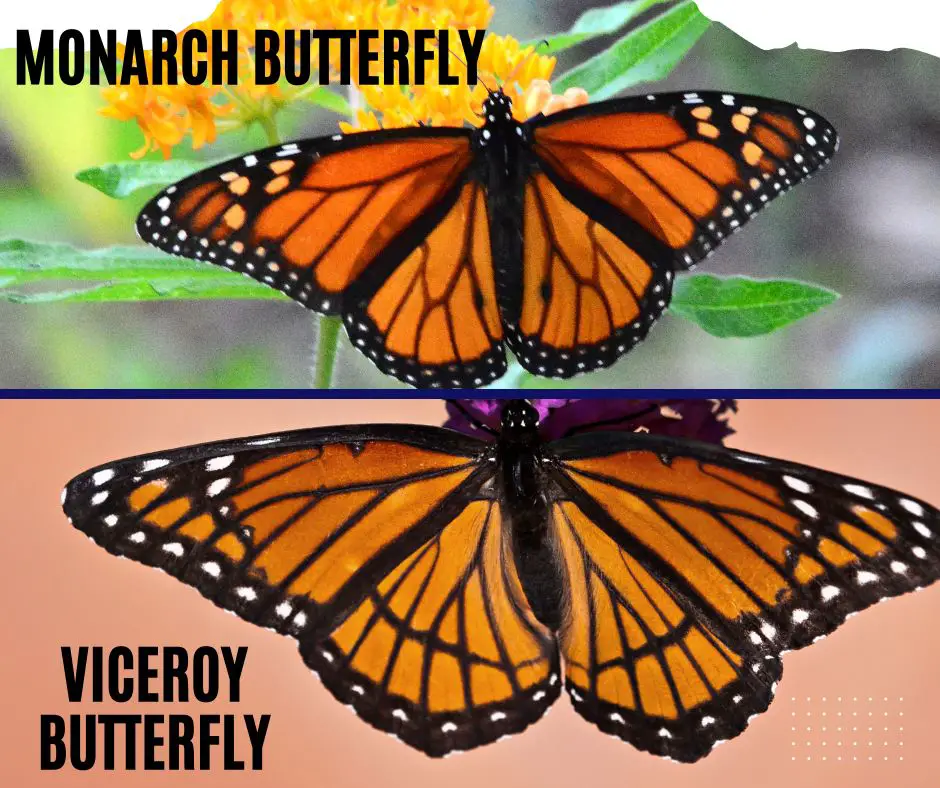Animals and insects have adopted various unique techniques in order to survive in the wild. Some adaptations are like super powers allowing the animal to exhibit unique abilities while others just use visual deception in order to stay safe. Viceroy butterflies are one of those insects that employ the art of deception in order to keep itself safe from being hunted. It acts like a monarch butterfly deceiving its predators. You might wonder why do viceroy butterflies copy the monarch butterflies, here we have gathered complete information on this for you. So keep on reading till the end and let us know what you think about this natural phenomenon.
Why do viceroy butterflies copy the monarch butterflies?
Viceroy butterflies copy the monarch butterflies because they want to fool predators into thinking they are poisonous. The monarch butterfly is poisonous to many predators, so by copying its appearance, the viceroy butterfly can avoid being eaten. This is an example of Batesian mimicry, where a harmless species copies the appearance of a harmful species to avoid being eaten.
Does viceroy butterfly copy monarch?
Because viceroys look like monarchs, the viceroys benefit because the birds learn to avoid them as they do the monarchs. This kind of mimicry, where one insect tastes bad (the monarch) and the other tastes good (the viceroy), is called Batesian Mimicry.Aug 31, 1995
Viceroy butterflies are often thought to be monarch butterflies because of their similar appearance. However, viceroys are actually quite different from monarchs. For one, viceroys are smaller than monarchs. They also have a different number of black spots on their wings. So, why do viceroy butterflies copy the monarch butterflies?
The answer may have to do with predators. Both the monarch and viceroy butterflies are poisonous to many predators, such as birds. The monarch gets its poison from the milkweed plant, which it eats as a caterpillar. The viceroy, on the other hand, does not eat milkweed. Instead, it gets its poison from the willow tree.
Now, here’s where it gets interesting. Birds are not affected by the poison in milkweed, but they are affected by the poison in willows. So, by looking like a monarch, the viceroy butterfly is able to fool predators into thinking it is also poisonous. This gives the viceroy a better chance of survival.
There is another benefit to looking like a monarch butterfly. Monarch butterflies are known to migrate long distances. By appearing similar to the monarch, the viceroy butterfly may also be able to take advantage of this migration pattern and travel to new areas.
So, the next time you see a viceroy butterfly, don’t be fooled by its appearance. This little butterfly is quite different from the monarch, but it has adapted to look like its more famous cousin in order to survive.
What is a look alike for the monarch butterfly?
Viceroy butterflies are often mistaken for monarch butterflies because of their similar appearance. The two species are in the same family, but the viceroy is actually a Batesian mimic of the monarch. This means that the viceroy has evolved to look like the monarch in order to fool predators into thinking that it is poisonous. The viceroy is not poisonous, but the monarch is.
The viceroy butterfly first evolved in North America, and the monarch butterfly later evolved in Central America. Both species eventually spread to other parts of the world. It is believed that the two species started to mimic each other when they came into contact with each other in Central America.
The viceroy butterfly has several physical traits that mimic the monarch butterfly. For example, the viceroy has black and orange markings on its wings, and the monarch has black and white markings. The viceroy also has a slightly different wing shape and body size.

The two species also behave differently. Monarch butterflies are known for their long-distance migrations, while viceroys do not migrate. Monarch butterflies also gather in large groups, while viceroys do not.
There are a few theories about why the viceroy evolved to mimic the monarch. One theory is that the viceroy evolved to take advantage of the monarch’s chemical defenses. The monarch produces a chemical called cardenolide, which is poisonous to predators. By mimic the monarch, the viceroy can deter predators even though it does not produce this chemical itself.
Another theory is that the viceroy evolved to take advantage of the monarch’s warning coloration. The monarch’s black and white markings are a warning to predators that it is poisonous. The viceroy’s resemblance to the monarch might make predators think twice about attacking it.
It is also possible that the viceroy evolved to mimic the monarch for both of these reasons. The viceroy has been able to successfully mimic the monarch and avoid being eaten by predators. This mimicry has allowed the viceroy to spread to different parts of the world.
In some areas, the viceroy has even outcompeted the monarch butterfly. This is because the viceroy can tolerate a wider range of environmental conditions than the monarch. The viceroy is also better at avoiding predators and parasitoids.
The viceroy’s mimicry of the monarch has been a successful evolution strategy. The viceroy has been able to avoid being eaten by predators and has even outcompeted the monarch in some areas.


Leave a Reply